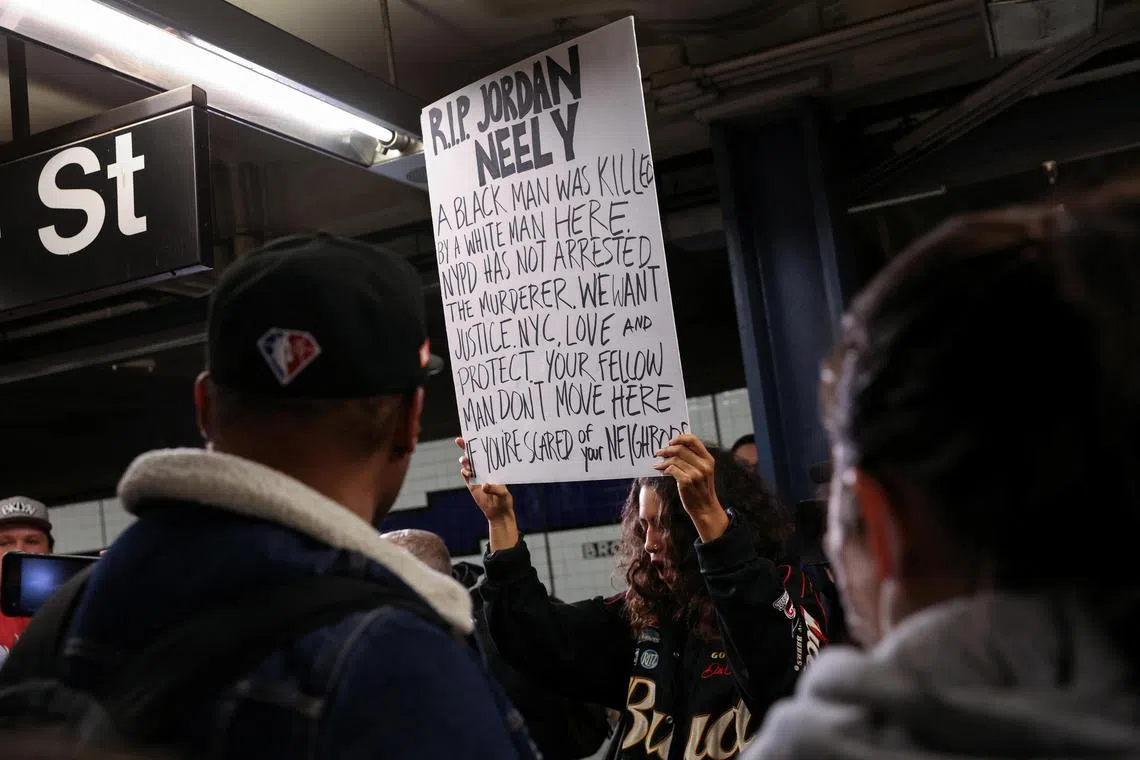Chokehold death of man on New York City subway is ruled a homicide
Sign up now: Get ST's newsletters delivered to your inbox

Mr Jordan Neely had been screaming at passengers when the other rider wrapped his arms around his neck and head until he went limp.
PHOTO: REUTERS
Follow topic:
NEW YORK – The death of a New York City subway rider who was placed in a chokehold by another passenger on Monday was ruled a homicide, the city’s medical examiner confirmed on Wednesday evening.
The man who died, Mr Jordan Neely, was homeless and had been screaming at passengers when the other rider wrapped his arms around Mr Neely’s neck and head and held him for several minutes until he went limp. Mr Neely died from compression to his neck as a result of the chokehold, according to Ms Julie Bolcer, a spokesperson for the medical examiner.
The killing, on an F train in Manhattan, has led to investigations by both the police and prosecutors, said a spokesperson for Manhattan District Attorney Alvin Bragg. As of Wednesday afternoon, nobody had been arrested.
“As part of our rigorous ongoing investigation, we will review the Medical Examiner’s report, assess all available video and photo footage, identify and interview as many witnesses as possible, and obtain additional medical records,” the district attorney’s spokesperson said in a statement.
“This investigation is being handled by senior, experienced prosecutors and we will provide an update when there is additional public information to share,” he added.
On Monday, a man who was riding in the same subway car went up to Mr Neely, a 30-year-old Michael Jackson impersonator who was yelling that he was hungry and ready to die. The 24-year-old man who choked Mr Neely has not been identified.
The episode, filmed on a nearly four-minute video that shows other riders helping to pin down Mr Neely while others looked on, has led to a police investigation and spurred advocates for the homeless, city officials and others to call for an arrest. Governor Kathy Hochul said she needed to review the incident more closely but called the man’s death troubling.
“It was deeply disturbing,” she told reporters.
The incident comes as the city grapples with how to reduce both crime and the number of people with mental illness living on the streets, while also respecting the rights of its most vulnerable residents.
The two issues have become the twin focuses of Mayor Eric Adams, who has sent more police to patrol train stations and to sweep homeless encampments even as he has supported policies that offer a gentler approach to people who are homeless and mentally ill.
Any criminal case could come down to whether the man who placed the rider in a chokehold was justified in using force, according to legal specialists.
Under New York law, a person may use physical force on another person if they have a reasonable belief that it is necessary to defend themselves or others. But a person can only use deadly physical force if they have reason to believe that an attacker is doing or about to do the same.
Police and prosecutors must determine what the intentions of the rider were when he grabbed Mr Neely, if the rider felt physically threatened and if other passengers believed they had a reason to fear for their safety, said Ms Karen Friedman Agnifilo, a former prosecutor in the Manhattan district attorney’s office.
“The DA’s office is going to do a painstaking investigation where they are going to interview every witness and look at the video frame by frame,” she said.
The police, who questioned the 24-year-old man and let him go on Monday night, said they were investigating the death. A spokesperson for the Manhattan district attorney said they were also investigating. An official briefed on the investigation confirmed Mr Neely’s identity, though the police had yet to do so Wednesday evening.
Mr Adams called the death “tragic”, and said “there’s a lot we don’t know about what happened here.” He added, “However, we do know that there were serious mental health issues in play here, which is why our administration has made record investments in providing care to those who need it and getting people off the streets and the subways, and out of dangerous situations.”
“There was no empathy on that train car,” said Mr Karim Walker, an organising and outreach specialist at the Urban Justice Centre, who works with people who are homeless. There should be accountability for Mr Neely’s death, he said.
“He did not need to nor did he deserve to die in the manner that he did,” Mr Walker said. “That’s what really scares me, and that’s what really breaks my heart.”
Witnesses said Mr Neely was acting in a “hostile and erratic manner” towards other passengers on the train, according to police.
Mr Juan Alberto Vazquez, a freelance journalist who was riding on the train and who shot the video, said the victim was yelling about being hungry and thirsty. “‘I don’t mind going to jail and getting life in prison,’” Mr Vazquez recalled him saying. “‘I’m ready to die.’”
That kind of language might have led other passengers to believe that Mr Neely was going to do something violent, said Mr Todd Spodek, a criminal defence lawyer.
“I imagine that the collective feeling on that train was that something was happening,” he said. NYTIMES

